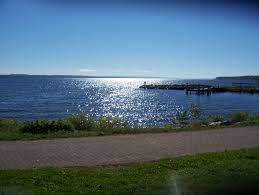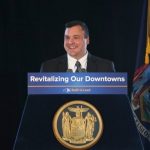
This guest blog is by ELGL member Matt Horn, the Director of Municipal Services for the MRB Group. We’re bloggin’ all month about parks and open space management as part of the 2019 #ELGLKnope bracket challenge to find the best public places in America!
 Change can be tough in local government. Change that costs money can be even tougher. For a fiscally constrained community (is there any other kind?), the idea of allocating funds to acquire new parkland, or even getting significant funding for improvements to existing play spaces gets piled on to the capital planning needs of the community, along with water projects, new police cars and fire trucks, and the glitz and glamour of a replacement payloader.
Change can be tough in local government. Change that costs money can be even tougher. For a fiscally constrained community (is there any other kind?), the idea of allocating funds to acquire new parkland, or even getting significant funding for improvements to existing play spaces gets piled on to the capital planning needs of the community, along with water projects, new police cars and fire trucks, and the glitz and glamour of a replacement payloader.
All too often, parks are viewed as a luxury, and are relegated to the back of the capital planning line. After all, how could a happy little tire swing compete with the pomp and circumstance of an asphalt mixer?
As with most innovations in the local government sector, the best path starts with the people themselves. Around the country, residents and shop owners are taking the initiative to create incremental change in their communities—and parks and open space are at the top of the list.
In the planning world, they call it tactical urbanism. For parks, we should coin the term “guerilla recreation.”
While this does give the mental image of revolutionary rebels taking time off from polishing their AK-47s to play a quick game of Four Square, in this case we’re talking about low cost, incremental development of neighborhood amenities without mega government involvement.
Here are three quick case studies from my hometown of Geneva, NY. I worked in Geneva at the depth of the great recession, and finding funds to support recreation was like convincing Ben Wyatt that calzones will always play second fiddle to pizza.
But Geneva has an active, engaged constituency of residents who weren’t taking “I’m not sure we can afford that” for an answer. Here are three initiatives they got moving to community acclaim:
- Downtown Parklets: Parklets have been around in urban communities for a long time. Our local shop owners saw these pop-up open spaces as a solution to a challenging urban topography (lots of competition for sidewalk space and too much asphalt), sometimes small storefronts (limited seating options), and their customers’ desire to spend as much time in the Finger Lakes sunshine as absolutely possible.
We knew that it would take a limited deployment to build community consensus around the idea, so we engaged the local college architecture program, the Business Improvement District, and the Chamber of Commerce to create a competition for parklet design. Ultimately we selected two designs which the students helped build. Today, the City manages a program whereby store owners can submit their designs and multiple parklets can be deployed each year.
- Activating Vacant Lots: The City’s zoning code just celebrated its 40th anniversary without a significant re-write. While 40 is a great number for marriages, it tends to be a challenging number for zoning and development. Many lots in the City, which would support the building trends of today, are non-conforming for development according to the standards set during the Nixon era. As such, there are lots of empty lots, yearning for activity—many of which are City-owned.
One of the City’s active neighborhood associations took on one such lot; working with their neighbors to create a design, and working themselves on the weekends to build a micro-park on the site. The association even programs and maintains the site.When a group of active residents approaches you saying we’ll design it, we’ll build it, we’ll maintain it, and we’ll program it; it’s nearly impossible to say no. Today the micro-park is home to neighborhood gatherings, concerts, and is the review stand for the mini-parade that neighbors put on each 4th of July - Repurposing Fallow Play Spaces: Lots of things can cause a playspace to go dormant— design, location, maintenance challenges, evolving play trends…sometimes all of those converge in a single area. In Geneva, they had one such park. A beautiful concept—a wide open space in a compact, urban downtown. Great seating, a beautiful fountain, breathtaking views of Seneca Lake. In fact, I can only think of one thing missing—people.
In 2017, the City enlisted the help of the newly formed Youth Council, and received funding from a philanthropic agency to develop some upgrades to the space. The Youth Council engaged with their friends and a local artist to design sidewalk art with built-in play elements. The art even changes designs in the rain to create a neat public art project. Since then, another group of engaged youth has developed an even broader concept for activating the space; which the City has endorsed and is developing funding plans for.
I’ve observed some takeaways that made these and similar guerilla efforts successful and sustainable:
- Data. Data. Data: “How much is this going to cost the taxpayers?” “What’s the liability?” These are the typical choruses for new concepts in local government. Get all of the information necessary to address these issues before they stymie the idea. In the case of the parklets, there was resounding concern on behalf of the merchants about parking. How could we take up valuable parking spaces when there’s obviously a deficit? We enlisted the help of our trusty parking enforcement officer to do hourly, block-by-block surveys of parking occupancy. We were able to quickly address questions regarding parking. Merchants, however, often (rightfully so) take a “believe it when I see it” approach when data breaks with their experience. They’ve got a lot on the line, and are competing with highway commercial ventures with scores of parking. So, we did an “after-implementation” survey as well, to determine the impacts of the program. Turns out we could spare the four spaces.”
- Tackle the Tough Questions Up Front: When I was a kid, trying to see how far I could jump from the swings at the neighborhood park, I never dreamed about how controversial park locations and amenities could be. Questions about traffic, amenities, noise (imagine the horror of the excessive sounds of children laughing and playing), etc., can create a civil war of sorts in a neighborhood. My tendency is to try to downgrade the drama a bit, sometimes avoiding the tougher questions. Trust me, kicking the can down the road never works (e.g. the 7 a.m. visitor to my front porch about…gasp…a bench placed outside of the planned amenities). As uncomfortable as it can be, take the time up front to grind out and settle all of the tougher issues before you implement.
- The End Users Should Design the Solution: As sad is it sounds, the best playground designer is probably not a group of 55 year old men in a conference room. Take the design conversation to the neighborhood, and get as many neighborhood kids around the picnic table as possible. However fantastical their ideas are, be sure to write them down and make the participants feel heard. Without overcommitting, worry about feasibility later. When you do have a feasible solution, take it back out to the neighborhood and be sure the kids buy in. There’s no sadder space than a perpetually unused playground or park.
As with most change initiatives, the work is tough. Thankfully, in this case, you’ll have an army of engaged residents and stakeholders there to do the bulk of the heavy lifting. Now go outside and play! And don’t slam the screen door on your way out…
